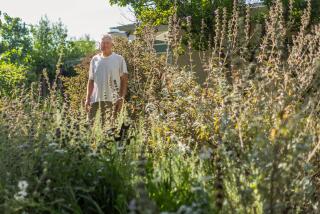SPECIAL ISSUE: SPRING HOME & GARDEN GUIDE : GARDEN GAFFES : Watering in Winter Can Damage Plants
- Share via
In the world of gardening, the phrase “too much of a good thing” can take on extra meaning. During the cool winter that Orange County has experienced, many people have been over-watering their plants, especially container plants.
According to Wade Roberts, director of Sherman Gardens in Corona del Mar, it is common to give too much water to outdoor plants, and many plants fall victim to root rot as a result. A hanging plant commonly known as Concord blue is particularly susceptible. “They don’t like the cold,” Roberts said, and too much water can aggravate the problem.
If you have a Concord blue and winter has left it looking unhealthy, Roberts recommends giving it less water, trimming the plant back and waiting for the warm weather to restore it.
Over-watering can also plague bulbs in the garden. Many people keep their tuberous begonias too wet when they first plant them, Roberts said.
Impatience is another problem that can hurt the success of planted bulbs. Some people who plant tulips take the bulbs out of the refrigerator and plant them immediately on a hot day, or put them in a pot and push them into the warm sun.
The result, Roberts said, is that the bulb is not likely to bloom. The trick is to let the roots form before putting the bulbs in the ground, Roberts said.
Speaking of “too much of a good thing,” one of the problems that Jim Kitano of Kitano’s Garden Center in La Palma runs into regularly is the overuse of fertilizers and other chemicals on plants and lawns.
When some homeowners fertilize their lawns for spring and find that the recommended dose makes their grass green, “they assume that twice as much will make it twice as green,” Kitano said. But brown is often the color that results, because the grass cannot assimilate the extra chemicals.
The same goes for plant foods and other chemical garden aids. Many people simply do not read the labels, and often come back to Kitano’s wondering what went wrong when their plants die.
When people buy a medicine for themselves, “they read the package and they know what the dosage is,” Kitano said. “They should take the same care with plants. Chemicals are chemicals.”
Kidney-shaped back-yard pools are a familiar part of the Orange County landscape. But too often the pool is simply too big for the back yard, restricting pedestrian circulation around the pool and cutting down the area available for entertaining. The aesthetic effect can also be cramped.
Carl Vella, a landscape architect in Santa Ana, has one customer in Tustin whose pool comes to within a few feet of the house, making getting around the pool not only awkward but unsafe.
Vella’s solution involves major surgery--actually reducing the size of the pool.
With a typical 30-foot pool, he might build a wall across one end and cut the total length down to 20 feet, refilling the unwanted space with dirt. In most cases, as with the house in Tustin, he also angles the rounded corners of the pool, changing the kidney shape into something more geometric--and modern.
The result is better circulation around the pool, more space for entertaining and a less cramped look. The price tag for these improvements ranges from about $4,000 to $8,000 on a typical back-yard pool, Vella said.






